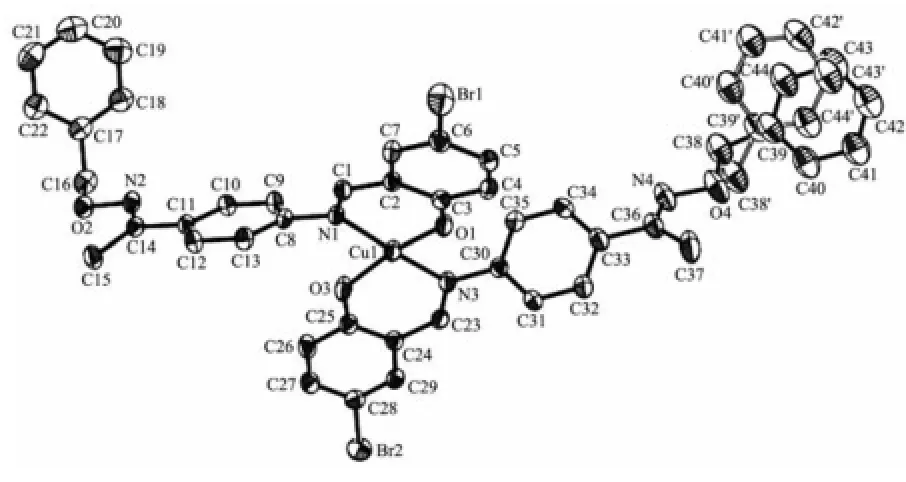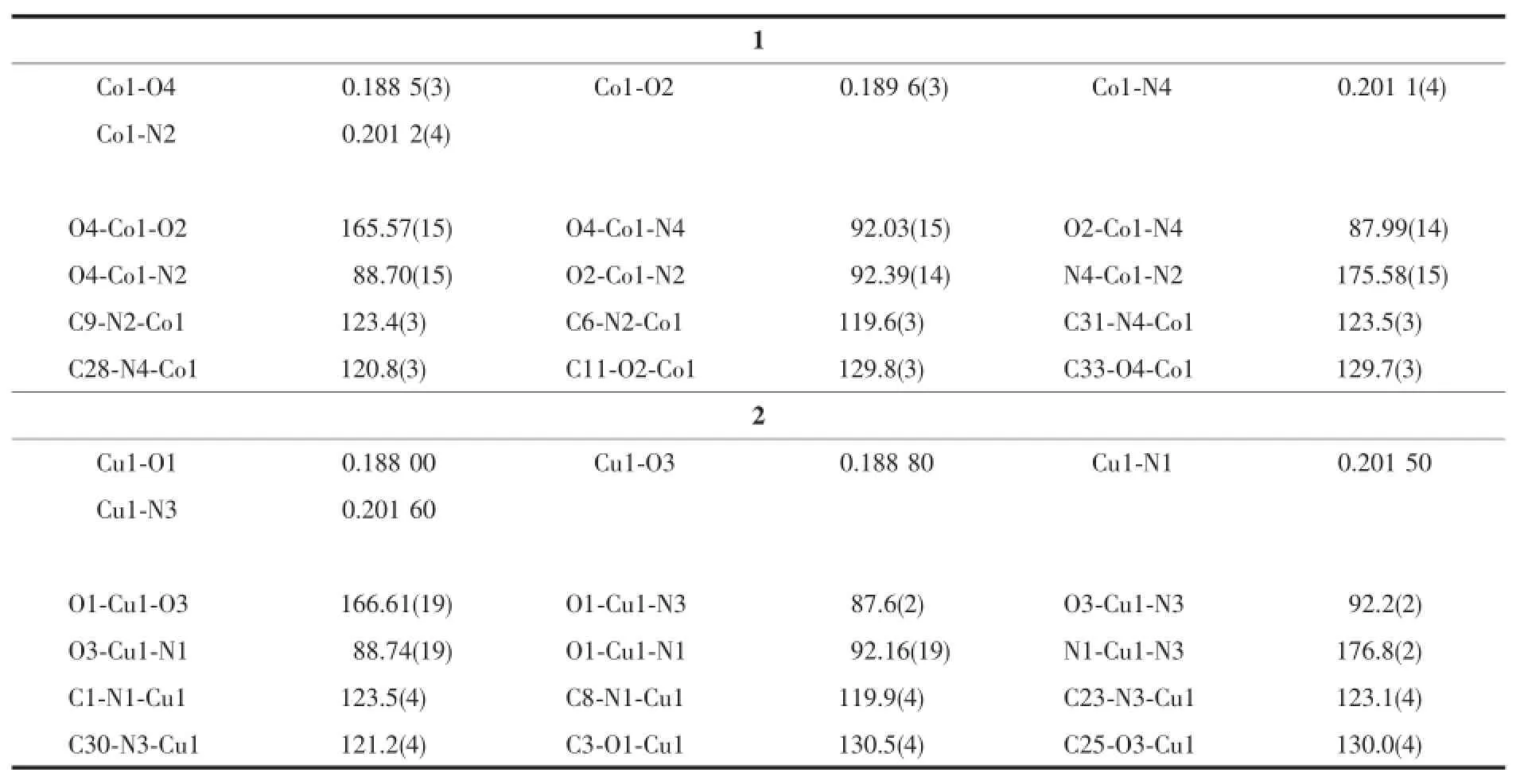含Schiff碱配体的超分子Co(Ⅱ)和Cu(Ⅱ)配合物的合成、表征及晶体结构
孙银霞 赵亚元 李春宇 俞 彬 郭建强 李 璟(兰州交通大学化学与生物工程学院,兰州 730070)
含Schiff碱配体的超分子Co(Ⅱ)和Cu(Ⅱ)配合物的合成、表征及晶体结构
孙银霞*赵亚元李春宇俞彬郭建强李璟
(兰州交通大学化学与生物工程学院,兰州730070)
摘要:合成了2个含肟基Schiff碱Co(Ⅱ)和Cu(Ⅱ)配合物Co(L1)2(1)和Cu(L2)2(2)。X射线单晶衍射分析结果表明,配合物1和2具有相似的结构,均由1个中心金属离子和2个双齿配体单元组成,且金属离子的配位数为4,具有平面四边形结构。配合物和2均属于三斜晶系,空间群均为P1。配合物1的晶胞参数为a=1.156 40(11)nm,b=1.376 81(12)nm,c=1.388 59(13)nm,α 63.776 0(10)°,β=87.400(2)°,γ=84.280(2)°;配合物2的晶胞参数为a=1.156 42(9)nm,b=1.372 19(13)nm,c=1.404 40(12)nm,α 63.683 0(10)°,β=87.227(2)°,γ=84.883 0(10)°。2个配合物分子均通过分子间C-H…O和C-H…π氢键作用以及分子间π…π堆积作用相连接,形成了二维层状超分子结构。
关键词:钴(Ⅱ)配合物;铜(Ⅱ)配合物;晶体结构;Schiff碱配体;超分子结构
兰州交通大学青年科学基金项目(No.2011007)、兰州交通大学研究生教改项目(No.160012)和甘肃省科技支撑计划项目(No.1204GKCA052)资助。
*通信联系人。E-mail:sun_yinxia@163.com
0 Introduction
Schiff base compounds have been a research focus of coordination chemistry because of their potential application in catalysis[1-2],bioscience[3-4],new materials[5],magneticproperties[6-9]and constructing supramolecular structures[10-11].At present,significant increases in the research of the transition metal complexes with these series Schiff base ligands have been observed.Herein,in order to further study the supramolecular structures of the transition metal complexes with the oxime-type Schiff base ligands,supramolecular Co(Ⅱ)and Cu(Ⅱ)complexes,Co(L1)2(1)and Cu(L2)2(2),with oxime-type Schiff base ligands(HL1=1-(4-{[(5-chlor-2-hydroxyphenyl)methylene]amino}phenyl)ethanone O-benzyloxime,HL2=1-(4-{[(3,5-bromine-2-hydroxyphenyl)methylene]amino}phenyl)ethanone O-benzyloxime)have been synthesized and characterized by elemental analyses,IR spectra,UV-Vis spectra and X-ray crystallographic analysis.
1 Experimental
1.1Materials
3-Aminoacetophenone, O-benzylhydroxylamine,halogen substituted salicylaldehyde were purchased from Aladdin and used without further purification. The other solvents were analytical grade from Tianjin Chemical Reagent Factory.
1.2Methods
C,H and N analyses were carried out with a GmbH Vario EL V3.00 automatic elemental analyzer. FT-IR spectra were recorded on a VERTEX70 FT-IR spectrophotometer,with samples prepared as KBr (400~4 000 cm-1).UV-Vis absorption spectra were recorded on a Shimadzu UV-2550 spectrometer.X-ray single crystal structure was determined on a Bruker Smart 1000 CCD area detector.Melting points were measured by a microscopic melting point apparatus made in Beijing Taike Instrument Limited Company and the thermometer was uncorrected.
1.3Synthesis of HL1and HL2
HL1and HL2were synthesized according to the analogous method[12-14].The synthetic route is given in Scheme 1.HL1:Yield 69.18%;m.p.149~150℃. Anal.Calcd.for C22H19ClN2O2(%):C,69.75;H,5.05;N,7.39.Found(%):C,70.23;H,5.11;N,7.28.HL2: Yield 59.09%;m.p.168~169℃.Anal.Calcd.for C22H19BrN2O2(%):C,62.42;H,4.52;N,6.62.Found (%):C,62.56;H,3.48;N,6.42.
1.4Synthesis of Co(L1)2(1)and Cu(L2)2(2)
A pale-pink ethanol solution(2 mL)of Co(Ⅱ)acetate tetrahydrate(0.50 mg,0.002 mmol)was added dropwise to an acetone solution(2 mL)of HL1(1.70 mg,0.004 mmol)at room temperature.The mixing solution turned to yellow immediately,then it was filtered and the filtrate was allowed to stand at room temperature for about one week.Red block single crystals suitable for X-ray structural determination wereobtained. Anal.Calcd.for C44H36Cl2CoN4O4(%):C,64.87;H,4.45;N,6.88.Found(%):C,64.72;H,4.34;N,6.78.The synthetic method of Cu(L2)2(2)is similar with Co(L1)2(1).Anal.Calcd.for C44H36Br2CuN4O4(%):C,58.19;H,4.00;N,6.17.Found(%):C,58.53;H,3.49;N,6.25.

Scheme 1 Synthetic routes of HL1and HL2
1.5Crystal structure determination
The single crystals of complexes 1 and 2 with approximate dimensions of 0.30 mm×0.27 mm×0.15 mm and 0.21 mm×0.14 mm×0.08 mm were placed on aBrukerSmart1000CCDareadetector.The diffractiondatawerecollectedusingagraphite monochromated Mo Kα radiation(λ=0.071 073 nm)at 298(2)K.Empirical absorption correction was applied to the data using SADABS program[15].The structures were solved by direct methods and refined by fullmatrix leastsquares method on F2using the SHELXTLprogram[16].All nonhydrogen atoms were refined anisotropically.All the hydrogen atoms were generated geometrically and refined isotropically using the riding model.Details of the crystal parameters,data collection and refinements for complexes 1 and 2 are summarized in Table 1.
CCDC:1003361,1;1473798,2.

Table 1 Crystal data and structure refinement for complexes 1 and 2

Table 2 Main bands in IR spectra of HL1,HL2and its Co(Ⅱ)and Cu(Ⅱ)complexes
2 Results and discussion
2.1IR spectra analyses
The FT-IR spectra of HL1,HL2and their corresponding complexes 1 and 2 exhibit various bands in the 400~4 000 cm-1region.The most important FT-IR bands for HL1,HL2and its Co(Ⅱ)and Cu(Ⅱ)complexes are listed in Table 2.
The characteristic C=N stretching bands of the free ligand HL1and HL2appear at 1 620 cm-1and 1 618 cm-1,respectively,while those of complex 1 and complex 2 are observed in the 1 613 cm-1and 1 605 cm-1,respectively.The C=N stretching frequencies are all shifted to lower frequencies by ca.7 and 13 cm-upon complexation respectively,indicating a decrease in the C=N bond order due to the coordinated bond of the metal atom with the imino nitrogen lone pair[17]. The Ar-O stretching bands of the ligands HL1and HL2are observed at 1 167 cm-1and 1 174 cm-1,respectively,which are at 1 160 cm-1and 1 159 cm-1for complex 1 and complex 2.The lower frequency of the Ar-O absorption shift indicates that M-O bond form between the metal ions and the oxygen atoms of the phenolic groups[18-19].In addition,the broad O-H group absorption bands at 3 445 cm-1and 3 433 cm-1in the free ligands HL1and HL2disappear in the spectra of the complexes 1 and 2,which further demonstrates the coordination of deprotonated phenolic oxygen atom to metal ion. The FT-IR spectrum of complex 1 shows ν(Co-N)andν(Co-O)vibration absorption frequencies at 512 cm-1and 470 cm-1(or 522 cm-1and 476 cm-1for complex 2),respectively.These assignments are consistent with the literature[20].
2.2UV-Vis absorption spectra analyses
The UV-Vis absorption spectra of HL1and its corresponding Co(Ⅱ)complex in dilute CH2Cl2solution areshowninFig.1.Theelectronicabsorption spectrum of free ligand HL1exhibits three absorption peaks at approximately 233,261 and 358 nm.The former absorption peaks at 233 and 261 nm can be assigned to the π-π*transition of the benzene rings and the latter at 358 nm can be attributed to the intraligand π-π*transition of the C=N group[21].Upon coordination of the ligand,the absorption at 358 nm disappears from UV-Vis spectra of the Co(Ⅱ)complex,indicating that the amino nitrogen is involved in coordination with Co(Ⅱ)ion[22].The intraligand π-π* transition of the benzene ring is bathochromically shifted to 245 and 312 nm in the Co(Ⅱ) complex,indicating the coordination of Co(Ⅱ) ion with deprotonated L-unit.The new peak at 410 nm of Co(Ⅱ)complex is assigned to L→M charge-transfer transition[23].

Fig.1 UV-Vis absorption spectra of HL1and the Co(Ⅱ)complex in dilute CH2Cl2solution at room temperature

Fig.2 UV-Vis absorption spectra of HL2and the Cu(Ⅱ)complex in dilute CH2Cl2solution at room temperature
UV-Vis absorption spectra of the free ligand HL2and its corresponding Cu(Ⅱ) complex in the dilute CH2Cl2solution is shown in Fig.2.The absorption of the Cu(Ⅱ) complex is obviously different from that of HL2owing to complexation.For the free ligand there are two intense peaks centered at around 285 and 359 nm,assigned to π-π*transitions of the benzene rings of the benzaldehyde and C=N groups,respectively[21]. Compared with the absorption peak of the free ligand,the absorption at 285 is slightly shifted bathochromically to 291 nm of the Cu(Ⅱ) complex,indicating the coordination of Cu(Ⅱ)ion with deprotonated L-unit.Meanwhile,the absorption peak at 359 nm disappears from the UV-Vis spectrum of the Cu(Ⅱ) complex,which indicates that the amino nitrogen atom is involved in coordination to the metal atom[22].In addition,a new absorption peak is observed at 404 nm in the Cu(Ⅱ)complex,which is assigned to then-π*chargetransfer from the filled pπ orbital of the bridging phenolic oxygen to vacant d-orbital of the Cu(Ⅱ)ions[24].
2.3Crystal structures of complexes 1 and 2
The structures of complexes 1 and 2 are similar,which are all mononuclear structure and crystallize in the triclinic system,P1 space group,and Z=2.Both of the complexes consist of one metal ion,two bidentate L-units.The molecular structures of the complexes 1 and 2 are shown in Fig.3 and 4,respectively,and selected bond lengths and angles are listed in Table 3.In the molecule structures of the complexes 1 and 2,the metal centers are tetra-coordinated slightly distorted square-planar geometry by two phenolic O and two imine N atoms from two deprotonated L-units.In the complexes,the bond lengths of M-N bond(~0.201 nm)are longer than M-O bond(~0.188 nm),which indicates L-has a little distortion probably as a result of the asymmetry.

Fig.3 Molecular structure of complex 1 showing 30% probability displacement ellipsoids

Fig.4 Molecular structure of complex 2 showing 30% probability displacement ellipsoids

Table 3 Selected bond lengths(nm)and bond angles(°)of the complex 1
In addition,complexes 1 and 2 have the sam intermolecular weak interaction.As shown in Fig.5 and Table 4,in the crystals of complexes 1 and 2 there are all two slipped π-π stacking between adjacent complexes,which involve the chelating rings and benzene rings.The interplanar centroid separation distance of π-π stacking interactions of Cg1…Cg2 in 1(or Cg3…Cg4 in 2)is 0.375 9(3)nm(or 0.377 5(3 nm),with a dihedral angle of 1.52°(or 2.25°).Th interplanar centroid separation distance of π-π stackin interactions of Cg2…Cg2iin 1(or Cg4…Cg4iin 2)i 0.370 5(3)nm(or 0.366 2(4)nm),with a dihedra angle of 0°(or 0°).These π-π stacking interaction link the adjacent molecules into a dimeric polymerFurthermore,this linkage is further linked into a 1D chains by a pairs of intermolecular C-H…O hydrogen bond formed between the-CH group of the benzene rings and the phenolic oxygen atom of adjacent molecules(Fig.6 and Table 5).In addition,1D chains are further linked by two pairs of intermolecular C-H …π hydrogen bonds interactions(Fig.7)to form a 2D supramolecular networks structure(Fig.8).

Table 4 Putative π-π stacking interactions for complexes 1 and 2*

Table 5 Hydrogen bonding Hydrogen-bonding for the complexes 1 and 2

Fig.5 π…π stacking interactions in the complexes 1 and 2

Fig.6 1D infinite chain supramolecular structure of the complexes via intermolecular C-H…O hydrogen bonding interactions and π-π stacking interactions
2.4Fluorescence spectra
Theemissionspectrumoftheligandsandcomplex 2 in dilute DMF solution at room temperature are shown in Fig.9.The ligand(HL2)exhibits an intense emission at 482 nm upon excitation at 300 nm,which should be assigned to intraligand π-π* transition.Compared with the free ligand,an extremely weak fluorescence intensity of the Cu(Ⅱ)complex is observed,indicating that fluorescent characteristic has been influenced by the introduction of the Cu(Ⅱ) ion However,compared with the ligand HL2,the ligand HL1and its Co(Ⅱ) complex show no fluorescence.I indicated that the substituted groups on the ligands couldplayasmallimpactonthefluorescence properties of complexes 1 and 2,which also give rise to the variations in IR and UV-Vis spectra in complexes 1 and 2.

Fig.7 1D infinite chain supramolecular structure of the complexes via C-H…π hydrogen bonding interactions

Fig.8 2D layer supramolecular structure of the complexes

Fig.9 Emission spectra of HL2(λex=300 nm,λem=482 nm)and complex 2 in dilute DMF at room temperature
3 Conclusions
Two Schiff base mononuclear Co(Ⅱ) and Cu(Ⅱ)complexes have been synthesized and characterized structurally.The structures of complexes 1 and 2 ar similar,althoughthetwoligandswithdifferen substituents.The Co(Ⅱ) and Cu(Ⅱ) complexes are al tetra-coordinated by two nitrogen atoms and two oxygen atoms of two deprotonated L-units definin the N2O2basal plane.The coordination environmen around Co(Ⅱ)and Cu(Ⅱ)atoms are best regarded as the square-planar geometry.Complexes 1 and 2 also form a2D-layersupramolecularstructurebydifferen intermolecular interaction,π…π interaction and C-H …O,C-H…π hydrogen bond interactions,respectively Consequently, theintermolecularnon-classica hydrogen-bonding plays a very important role in the construction of supramolecular networks structure.
References:
[1]Pini D,Mandoli A,Orlandi S,et al.Tetrahedron:Asymmetry 1999,10(20):3883-3886
[2]Yang H Q,Zhang L,Zhong L,et al.Angew.Chem.Int.Ed.2007,46(36):6861-6865
[3]Brewer C,Brewer G,Scheidt W R,et al.Inorg.Chim.Acta,2001,313(1):65-70
[4]Brayshaw P A,Bünzli J C G,Froidevaux P,et al.Inorg. Chem.,1995,34:2068-2076
[5]Miyasaka H,Matsumoto N,Okawa H,et al.J.Am.Chem. Soc.,1996,118(5):981-994
[6]Bencini A,Benelli C,Caneschi A,et al.J.Am.Chem.Soc.,1985,107(26):8128-8136
[7]Sasaki M,Manseki K,Horiuchi H,et al.J.Chem.Soc.,Dalton Trans.,2000,3:259-263
[8]Edder C,Piguet C,Bünzli J C G,et al.Chem.Eur.J.,2001,7(14):3014-3024
[9]Bünzli J C G,Piguet C.Chem.Rev.,2002,102(6):1897-1928
[10]Dong W K,Sun Y X,Zhang Y P,et al.Inorg.Chim.Acta,2009,362:117-124
[11]Dong W K,Sun Y X,Zhao C Y,et al.Polyhedron,2010,29 (9):2087-2097
[12]DONG Wen-Kui(董文魁),GONG Shang-Sheng(宫尚生),TONG Jun-Feng(同军峰),et al.Chinese J.Inorg.Chem.(无机化学学报),2010,26(10):1868-1874
[13]Dong W K,Tong J F,Sun Y X,et al.Transition Met.Chem.,2010,35:419-426
[14]DONG Wen-Kui(董文魁),TANG Xiao-Lu(唐晓璐),HE Xue -Ni(何雪妮),et al.Chinese J.Inorg.Chem.(无机化学学报),2009,25(3):528-532
[15]Sheldrick G M.SADABS,University of Göttingen,Germany,1996.
[16]Sheldrick G M.SHELXS 97,Program for Refinement of Crystal Structures,University of Göttingen,Germany,1997.
[17]Asadi M,Jamshid K A,Kyanfar A H.Inorg.Chim.Acta,2007,360:1725-1730
[18]Kohawole G A,Patel K S.J.Chem.Soc.,Dalton Trans.,1981:1241-1245
[19]Majumder A,Rosair G M,Mallick A,et al.Polyhedron,2006,25:1753-1762
[20]Akine S,Taniguchi T,Nabeshima T.Inorg.Chem.,2004,43: 6142-6144
[21]Akine S,Taniguchi T,Nabeshima T.Chem.Lett.,2001,30: 682-683
[22]Smith H E.Chem.Rev.,1983,83:359-377
[23]Gomes L,Pereira E,Castro D B.J.Chem.Soc.,Dalton Trans.,2000,8:1373-1379
[24]DONG Wen-Kui(董文魁),LI Gang(李刚),LI Xiang(李翔),et al.Chinese J.Inorg.Chem.(无机化学学报),2014,30(8): 1911-1919
中图分类号:O614.121;O614.81+2
文献标识码:A
文章编号:1001-4861(2016)05-0913-08
DOI:10.11862/CJIC.2016.118
收稿日期:2016-01-20。收修改稿日期:2016-04-04。
Supramolecular Cobalt(Ⅱ)and Copper(Ⅱ)Complexes with Schiff Base Ligand:Syntheses,Characterizations and Crystal Structures
SUN Yin-Xia*ZHAO Ya-YuanLI Chun-YuYU BinGUO Jian-QiangLI Jing
(School of Chemical and Biological Engineering,Lanzhou Jiaotong University,Lanzhou 730070,China)
Abstract:Supramolecular cobalt(Ⅱ)and copper(Ⅱ) complexes,Co(L1)2(1)and Cu(L2)2(2),(HL1=1-(4-{[(5-chlor-2 hydroxyphenyl)methylene]amino}phenyl)ethanone O-benzyloxime,HL2=1-(4-{[(3,5-bromine-2-hydroxyphenyl)meth ylene]amino}phenyl)ethanone O-benzyloxime),have been synthesized and characterized structurally.X-ra structure showed that complexes 1 and 2 have the similar structure,consisting of one metal ion,two ligand units The complexes 1 and 2 both crystallize in triclinic system,space groups are P1 with the unit cell parameters fo complex 1:a=1.156 40(11)nm,b=1.376 81(12)nm,c=1.388 59(13)nm,α=63.776 0(10)°,β=87.400(2)°,γ= 84.280(2)°,and for complex 2:a=1.156 42(9)nm,b=1.372 19(13)nm,c=1.404 40(12)nm,α=63.683 0(10)°,β= 87.227(2)°,γ=84.883 0(10)°.The Co(Ⅱ)and Cu(Ⅱ)atoms are both four-coordinated in a trans-CuN2O2slightl distorted square-planar geometry by two hydroxyl O and two imine N atoms from two symmetry-related N,O bidentate Schiff base ligands.Moreover,every Co(Ⅱ)or Cu(Ⅱ) complex molecule links some other molecules into an infinite 2D layer supramolecular structure via intermolecular C-H…O hydrogen bonding,C-H…π and π-π stacking interactions between neighboring benzene rings.CCDC:1003361,1;1473798,2.
Keywords:Co(Ⅱ)complex;Cu(Ⅱ)complex;crystal structure;oxime-type ligand;supramolecular

